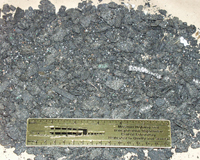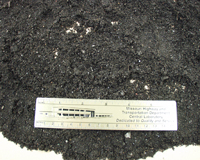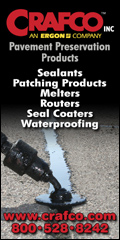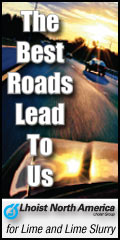| Tuesday, October 02, 2012 | ||
 |
 |
 |
| Past Issues | www.texasasphalt.org | Printer-Friendly | Subscribe | Advertise |
NCAT: Recomendations on Characterizing RAS
The use of recycled asphalt shingles (RAS) in asphalt mixes is on the rise. A recent survey conducted by the National Asphalt Pavement Association (NAPA) showed that RAS  use increased by more than 50 percent from 2009 to 2010. Nationwide, 1.1 million tons of RAS were recycled into asphalt mixes in 2010, conserving more than 200,000 tons of virgin asphalt binder. Based on a composite of average asphalt price indices published by 11 state DOTs in 2010, this translates into savings of approximately $100 million. While reducing material costs for asphalt mixes is a driving factor in the use of RAS, it also makes sense environmentally. In addition to conserving raw materials, using RAS in asphalt paving mixes resolves waste disposal issues and reduces the amount of shingles dumped in landfills. use increased by more than 50 percent from 2009 to 2010. Nationwide, 1.1 million tons of RAS were recycled into asphalt mixes in 2010, conserving more than 200,000 tons of virgin asphalt binder. Based on a composite of average asphalt price indices published by 11 state DOTs in 2010, this translates into savings of approximately $100 million. While reducing material costs for asphalt mixes is a driving factor in the use of RAS, it also makes sense environmentally. In addition to conserving raw materials, using RAS in asphalt paving mixes resolves waste disposal issues and reduces the amount of shingles dumped in landfills.RAS contains asphalt binder, organic fibers or fiberglass,  mineral aggregate and mineral filler. RAS is available from two distinct sources: manufacturing waste (MW) and post-consumer (PC) waste. PC or tear-off shingles are removed from houses or buildings during reroofing and typically contain higher asphalt contents due to weathering of the surface granules. Exposure to the sun over time also oxidizes the asphalt binder, producing a stiffening effect. The asphalt binder present in MW shingles has been aged due to the air-blown production process but is less stiff than PC RAS binder. mineral aggregate and mineral filler. RAS is available from two distinct sources: manufacturing waste (MW) and post-consumer (PC) waste. PC or tear-off shingles are removed from houses or buildings during reroofing and typically contain higher asphalt contents due to weathering of the surface granules. Exposure to the sun over time also oxidizes the asphalt binder, producing a stiffening effect. The asphalt binder present in MW shingles has been aged due to the air-blown production process but is less stiff than PC RAS binder.Many state agencies limit the amount of RAS in asphalt mixes—typically 5 percent or less by weight of the aggregate. Other states are beginning to move toward specifications that limit the percentage of recycled binder. In either case, successful RAS mixes depend on correct processing and handling of the RAS material. Mixes containing RAS must also be properly designed in order to be cost effective and to ensure good mix performance. An integral part of mix design is characterizing the RAS components. Processing and Handling RAS Shingles must be processed, or ground, before being used in asphalt paving mixes. Deleterious materials such as nails, wood and other debris should be removed prior to grinding. These contaminants are more often present in PC than MW shingles. However, the grinding process is typically easier for PC shingles, since the asphalt has been further aged and is more brittle than in MW shingles. As heat accumulates during grinding, the asphalt in MW shingles becomes more plastic, making it difficult to achieve a uniformly ground product. The current specification (AASHTO MP 15-09 Use of Reclaimed Asphalt Shingles as an Additive in Hot-Mix Asphalt) states that RAS should be ground such that 100 percent passes the 12.5-mm (½-inch) sieve. However, many contractors have found it beneficial to have a finer grind of RAS such as a 3/8-inch top size. A finer grind ensures maximum economic benefit by increasing the amount of usable asphalt and also improves mat placement and quality. RAS particles should be ground to a uniform size to facilitate good blending during production. MW and PC shingles should be stockpiled separately since the characteristics of each are very different. Other stockpile concerns include the following:
RAS Asphalt RAS binders are stiffer and have different rheological properties than virgin or modified binders since they are air-blown during shingle production. PC RAS binder is also stiffer than MW due to further aging on roofs. Asphalt Content The current standard for RAS mix designs (AASHTO PP 53-09 Design Considerations When Using Reclaimed Asphalt Shingles in New Hot-Mix Asphalt) require that the asphalt content of RAS samples be determined using chemical extraction methods. However, both agencies and contractors desire to minimize the use of solvent extractions due to the hazardous chemicals involved. The ignition oven method (AASHTO T 308) is a popular alternative for determining the asphalt content of recycled asphalt pavement (RAP), but some organizations are reluctant to use this method with RAS. In addition to burning off asphalt, the excessive heat of the ignition oven can cause aggregate breakdown or the ignition of other RAS material components. Thus, a material-specific asphalt correction factor must be determined in order to account for this material loss. Developing an asphalt correction factor for RAS is difficult, however, due to the uncertain composition of RAS. In the absence of an appropriate ignition oven correction factor, chemical extraction should be used to determine RAS asphalt content. With same-source RAS, comparisons should be made between the asphalt contents determined by chemical extraction and ignition oven to determine their relative closeness. PG Grading PG grading for RAS binder is not required by most states. However, AASHTO PP 53-09 suggests that the virgin binder grade be based on a blending equation similar to that used for high RAP content mixes. This requires the RAS binder be extracted, recovered, and tested using standard asphalt binder Performance Grading procedures. However, this process is quite challenging for RAS binders. Further aging in the rolling thin-film oven (RTFO) and pressure-aging vessel (PAV) makes the material difficult to mold and characterize. Furthermore, since most RAS binders have a critical high temperature greater than the boiling point of water, standard dynamic shear rheometers (DSRs) cannot be used for RAS PG grading. RAS Aggregate RAS contains aggregate granules that substitute for a portion of virgin aggregate in an asphalt mix. Thus, for accurate mix design, the aggregate portion of RAS should be characterized in terms of gradation, specific gravity, consensus aggregate properties and deleterious materials. Gradation AASHTO T 30 is the test method used for determining the gradation of extracted aggregate. Again, there is the dilemma of whether to use solvent extraction or the ignition oven to extract RAS aggregate, as solvent extraction involves the negative aspect of handling potentially hazardous chemicals. AASHTO PP 53-09 lists an assumed RAS aggregate gradation for use in mix design. However, a comparison of limited data from NCAT and other sources concluded that this assumed gradation could be inappropriate for RAS mix design. RAS aggregate gradation should be determined, not assumed, but strong conclusions could not be made from the limited data as to whether chemical extraction or ignition oven is the most appropriate means of recovering RAS aggregate for gradation testing. Bulk Specific Gravity In order to compute volumetric mix design properties such as voids in mineral aggregate (VMA), bulk specific gravity of the RAS aggregate must be determined. It is most practical, and fully acceptable per AASHTO PP 53-09, to use the effective specific gravity of RAS aggregate in place of its bulk specific gravity. Effective specific gravity can be calculated using standard theoretical maximum specific gravity testing (AASHTO T 209). To prevent RAS particles from floating to the top of the water during this test, alcohol can be misted onto the surface, or hot water (170°F) may be used to promote settling (in which case the sample must be cooled down to room temperature before applying vacuum pressure). Alternatively, the vacuum-sealing method (AASHTO T 331) may be used to backcalculate RAS aggregate effective specific gravity. Consensus Aggregate Properties Since aggregate provides the skeletal framework of an asphalt mix, it is vital that all aggregate, including recycled materials, are of sufficient quality to ensure satisfactory mix performance. Although little has been written concerning the consensus aggregate properties of RAS fine aggregate, states should ensure that common fine-aggregate testing is conducted. This will help prevent any stability or workability problems with the mix. Deleterious Materials While MW shingles are typically free of deleterious materials, PC shingles may contain such contaminants as wood, nails, plastics and other debris. These extraneous materials must be minimized. Limits are specified in AASHTO MP 15-09; however, several states such as Minnesota and Texas have developed more stringent specifications to limit the amount of deleterious materials in their RAS piles. Asbestos Concerns All recycled materials used in roadway projects are required by federal regulations to contain less than 1 percent asbestos, since exposure to asbestos fibers is known to increase the risk of lung cancer. U.S. shingle producers have not used asbestos since the 1980s, but manufacturers should be required to ensure that MW RAS is asbestos-free. Asbestos testing should be conducted on all PC RAS. A list of laboratories accredited for asbestos testing is maintained on the Web site for the National Institute of Standards and Technology at http://ts.nist.gov/standards/scopes/programs.htm. Two methods are available for asbestos testing: polarized light microscopy (PLM) and transmission electron microscopy (TEM). The most sophisticated means of identifying and quantifying asbestos fibers in RAS is TEM. After sampling and testing a RAS stockpile for asbestos, it is critical not to add other RAS material to the stockpile. This will prevent possible contamination of a stockpile that has been certified asbestos-free. Following these guidelines should promote the production of high-quality RAS asphalt mixes, which are a cost-effective and environmentally sound choice for both the asphalt industry and taxpayers. |
Asphalt: Smooth | Durable | Quiet | Safe






